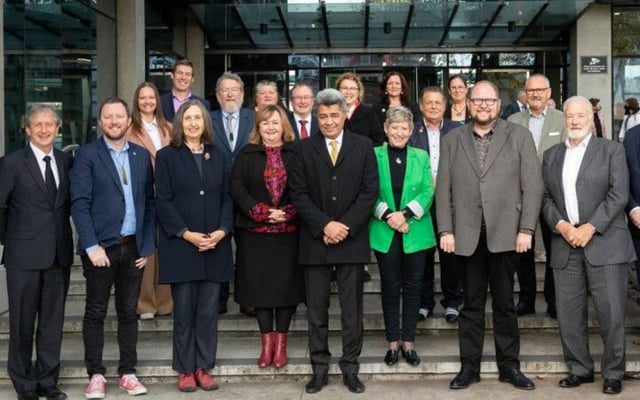MOA signals exciting time for Greater Christchurch sub-region

Christchurch with a population of over 50,000 is the second-largest city in New Zealand, and the Greater Christchurch sub-region is the fastest-growing outside Auckland. The sub-region represents Christchurch city and the neighbouring districts of Selwyn and Waimakariri from Rolleston to Rangiora.
Greater Christchurch currently has the most affordable housing of NZ's major urban centres, with a lifestyle that is highly valued by residents.
It is also the primary economic, service and logistics hub for the South Island – home to New Zealand's second-largest airport and third largest seaport, four tertiaries, six Crown Research Institutes, and a strong and diverse economic base that is strongly inter-connected with the wider regional economy.
Signalling an even more exciting time for Greater Christchurch, an MOA was signed earlier this week in the presence of Minister of Housing Megan Woods, Minister of Local Government Nanaia Mahuta, and members of the existing Greater Christchurch Partnership to set up an Urban Growth Partnership for Greater Christchurch or the Whakawhanake Kainga Committee.
The Urban Growth Partnership aims to align decision-making processes, collaborate on the strategic direction, and improve coordination across housing, land use and infrastructure planning.
The Committee also listed the priorities, which include:
- Decarbonising the transport system
- Increasing resilience to natural hazards and the effects of climate change
- Accelerating the provision of quality, affordable housing; and
- Improving access to employment, education and services.
The Greater Christchurch Partnership has in the past exploring the possibility of a Mass Rapid Transit and its implications. At the meeting this week, the Committee agreed on the next steps to develop a joint Greater Christchurch Spatial Plan, that focuses on a high capacity and frequency public transport (Mass Rapid Transit).
The Mass Rapid Transit investigations for Greater Christchurch will initially focus on the Riccarton and Papanui corridors with possible expansion to the Selwyn and Waimakariri Districts. Its notable that currently, Greater Christchurch has one of the highest dependency on private motor vehicle use of the urban areas in NZ.
Mayor Lianne Dalziel says the Committee offers exciting possibilities to "get ahead of the game" in relation to planning for future growth in Greater Christchurch. Achieving an Urban Growth Partnership for Greater Christchurch is a significant step and will bring massive benefits to the people of the region.
"We have the opportunity, with all the partners around this table to drive collective action to plan for an ambitious future for the sub-region. This will future-proof Greater Christchurch for generations to come. The work will also be useful as a building block in a dynamic reform environment" she says.
"Greater Christchurch is growing rapidly and housing is a fundamental part of people's wellbeing. Through the Spatial Plan we need to ensure that we are enabling diverse and affordable housing in locations that support thriving neighbourhoods, which provide for residents' day-to-day needs," Mayor Dalziel said.
Minister Megan Woods highlighted the significant change ahead in terms of urban development throughout the country. She mentioned the setting up of Urban Growth Partnerships around the country, with the same objective as that of the Greater Christchurch; to have strong partnerships for future growth, ensuring smooth planning for housing, transport and other supporting infrastructure meeting the needs of our communities.
"This is an exciting forum for Greater Christchurch. It will help us understand local issues and work on effective solutions together to unlock urban development opportunities," Minister Woods said.
The next step for the Spatial Plan is the development of the draft for public consultation.

Christchurch with a population of over 50,000 is the second-largest city in New Zealand, and the Greater Christchurch sub-region is the fastest-growing outside Auckland. The sub-region represents Christchurch city and the neighbouring districts of Selwyn and Waimakariri from Rolleston to Rangiora.
...
Christchurch with a population of over 50,000 is the second-largest city in New Zealand, and the Greater Christchurch sub-region is the fastest-growing outside Auckland. The sub-region represents Christchurch city and the neighbouring districts of Selwyn and Waimakariri from Rolleston to Rangiora.
Greater Christchurch currently has the most affordable housing of NZ's major urban centres, with a lifestyle that is highly valued by residents.
It is also the primary economic, service and logistics hub for the South Island – home to New Zealand's second-largest airport and third largest seaport, four tertiaries, six Crown Research Institutes, and a strong and diverse economic base that is strongly inter-connected with the wider regional economy.
Signalling an even more exciting time for Greater Christchurch, an MOA was signed earlier this week in the presence of Minister of Housing Megan Woods, Minister of Local Government Nanaia Mahuta, and members of the existing Greater Christchurch Partnership to set up an Urban Growth Partnership for Greater Christchurch or the Whakawhanake Kainga Committee.
The Urban Growth Partnership aims to align decision-making processes, collaborate on the strategic direction, and improve coordination across housing, land use and infrastructure planning.
The Committee also listed the priorities, which include:
- Decarbonising the transport system
- Increasing resilience to natural hazards and the effects of climate change
- Accelerating the provision of quality, affordable housing; and
- Improving access to employment, education and services.
The Greater Christchurch Partnership has in the past exploring the possibility of a Mass Rapid Transit and its implications. At the meeting this week, the Committee agreed on the next steps to develop a joint Greater Christchurch Spatial Plan, that focuses on a high capacity and frequency public transport (Mass Rapid Transit).
The Mass Rapid Transit investigations for Greater Christchurch will initially focus on the Riccarton and Papanui corridors with possible expansion to the Selwyn and Waimakariri Districts. Its notable that currently, Greater Christchurch has one of the highest dependency on private motor vehicle use of the urban areas in NZ.
Mayor Lianne Dalziel says the Committee offers exciting possibilities to "get ahead of the game" in relation to planning for future growth in Greater Christchurch. Achieving an Urban Growth Partnership for Greater Christchurch is a significant step and will bring massive benefits to the people of the region.
"We have the opportunity, with all the partners around this table to drive collective action to plan for an ambitious future for the sub-region. This will future-proof Greater Christchurch for generations to come. The work will also be useful as a building block in a dynamic reform environment" she says.
"Greater Christchurch is growing rapidly and housing is a fundamental part of people's wellbeing. Through the Spatial Plan we need to ensure that we are enabling diverse and affordable housing in locations that support thriving neighbourhoods, which provide for residents' day-to-day needs," Mayor Dalziel said.
Minister Megan Woods highlighted the significant change ahead in terms of urban development throughout the country. She mentioned the setting up of Urban Growth Partnerships around the country, with the same objective as that of the Greater Christchurch; to have strong partnerships for future growth, ensuring smooth planning for housing, transport and other supporting infrastructure meeting the needs of our communities.
"This is an exciting forum for Greater Christchurch. It will help us understand local issues and work on effective solutions together to unlock urban development opportunities," Minister Woods said.
The next step for the Spatial Plan is the development of the draft for public consultation.










Leave a Comment